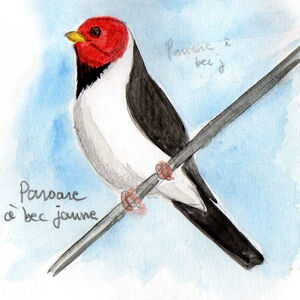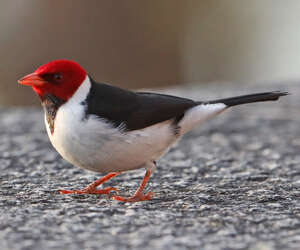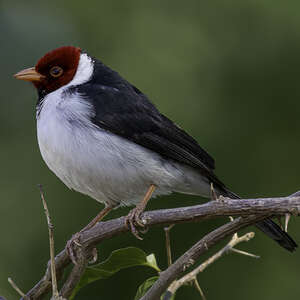Yellow-billed Cardinal
Paroaria capitata - Paroare à bec jaune
Identification
Is the Yellow-billed Cardinal a passeriform related to the Thraupidae, the Emberizidae or the Cardinalidae? One thing is for sure: you can immediately notice its vivid red head, its strong yellow beak, its black throat, its white stomach with white colour going up to its chest. A very clear white collar is visible between its red head and its black colour that reaches up to the nape, its coverts, its remiges and its tail are black. Its black eye has an almost red orange eyering and a dark, more or less clear mark that surrounds it depending on the individual. Its legs are yellow. There is no dimorphism between the sexes, the young will first have an orange head before getting their parents' red head.
Subspecific information monotypic species
Foreign names
- Paroare à bec jaune,
- Cardenilla piquigualda,
- cavalaria,
- Gelbschnabeltangare,
- vöröslábú kardinális,
- Geelsnavelkardinaal,
- Cardinale beccogiallo,
- gulnäbbad kardinaltangara,
- Gulnebbkardinal,
- kardinálka pláštiková,
- kardinál černohřbetý,
- Sortstrubet Kardinal,
- punapääkardinaali,
- sit cardenal becgroc,
- kardynałek żółtodzioby,
- Желтоклювая кардиналовая овсянка,
- キバシコウカンチョウ,
- 黄嘴蜡嘴鹀,
- gulnäbbad kardinaltangara,
- 黃嘴紅臘嘴雀,
Voice song and call
Habitat
Behaviour character trait
The Yellow-billed Cardinal does not migrate, it remains in pairs, often with its young during the learning period, and it meets in larger groups in normal times. It can be seen with the Crested Caridnal with which it can be confused if one is not paying attention, the crest being the distinctive element.
Dietfeeding habits
Reproduction nesting
The breeding season lasts from September to March, and the nest, shaped like a small cup, is made of plant fibers and rootlets. The nest can be found on the ground, in shrubs or in trees at a height of 4-6 m. It contains 3-4 eggs, which are greenish and ochre in color. Little information is available about the duration of the nest and the fledging of chicks in the wild; in captivity, the incubation period is 13/14 days long, and chicks start flying after 12 days.
Geographic range
Yellow-billed Cardinals have a particularly strong bond with the Pantanal in the Mato Grosso do Sul state and the bordering countries of Bolivia, Paraguay, northern Argentina, and northwest Uruguay. Unfortunately, Man has found Yellow-billed Cardinals to be an excellent pet bird (and sadly, cage bird) and imported them to the United States and Hawaii - from Hawaii the bird was able to escape and colonize other parts of the archipelago, including the namesake island. Yellow-billed Cardinals are also found in various states in the United States, having escaped from homes and pet shops.
Threats - protection
Sources of information
- IOC World Bird List (v15.1), Gill, F and D Donsker (Eds). 2025-12-07.
- A Field Guide to the Birds of Brazil, Ber Van Perlo
- BirdLife International, BirdLife International
- Neojohnston.org,
- Neotropical Birds Online,
- Whatbird,
- Wikipédia, Wikipedia, The Free Encyclopedia
- Handbook of the Birds of the World Vol 16, Josep del Hoyo, Andrew Elliott, David Christie
- Rossparkzoo,
Other sources of interest
 Specification sheet created on
30/07/2023 by Anne et Gabriel Leboff
Specification sheet created on
30/07/2023 by Anne et Gabriel LeboffTranslation by AI Oiseaux.net
© 1996-2025 Oiseaux.net
- Accipitriformes
- Aegotheliformes
- Anseriformes
- Apodiformes
- Apterygiformes
- Bucerotiformes
- Caprimulgiformes
- Cariamiformes
- Casuariiformes
- Charadriiformes
- Ciconiiformes
- Coliiformes
- Columbiformes
- Coraciiformes
- Cuculiformes
- Eurypygiformes
- Falconiformes
- Galliformes
- Gaviiformes
- Gruiformes
- Leptosomiformes
- Mesitornithiformes
- Musophagiformes
- Nyctibiiformes
- Opisthocomiformes
- Otidiformes
- Passeriformes
- Pelecaniformes
- Phaethontiformes
- Phoenicopteriformes
- Piciformes
- Podargiformes
- Podicipediformes
- Procellariiformes
- Psittaciformes
- Pterocliformes
- Rheiformes
- Sphenisciformes
- Steatornithiformes
- Strigiformes
- Struthioniformes
- Suliformes
- Tinamiformes
- Trogoniformes



























